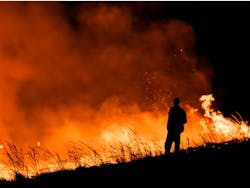California’s largest utilities were called before state regulators last week to discuss their plans “to reduce the use, scope, and impact” of public safety power shutoffs (PSPS), the problematic practice of de-energizing power lines to minimize the risk of sparking wildfires.
Though their individual territories dictate some customization, the major utilities are largely implementing similar PSPS enhancement strategies — rapidly deploying resilient microgrids, providing backup power to critical buildings and vulnerable populations, sectionalizing and hardening grid infrastructure, expanding communications and public affairs efforts, enhanced vegetation management, better rapid response capabilities, and new wildfire predictive technologies.
All three companies told the public utilities commission that they are on or ahead of schedule with their PSPS preparations and enhancements plans — but save for a few public comments, actually curtailing the use of the shutoffs writ large received scant attention.
‘A viable solution’
San Diego Gas & Electric presented the most ambitious strategy, aiming to reduce the shutoffs by 25-30% this year if conditions are the same as 2019. Southern California Edison (SCE) and Pacific Gas & Electric (PG&E) project reductions of 15-20% if all else is equal.
Commissioners reiterated throughout the separate hearings that shutoffs must be a ‘tool of last resort,’ but the utilities also made clear that de-energization is critical to their operations and strategies. Southern California Edison (SCE) noted in their slides that they expect “to reduce the scope, duration, and impact of PSPS; however, PSPS will continue to remain a viable solution for extreme conditions.”
Utilities shut off power to more than three million Californians at some point as a result of 19 PSPS events in October and November last year, often with little warning. SCE has already called two PSPS events this year — one in May and one in June, before the official September commencement of wildfire season. (Utilities were quick to point out on social media that rolling blackouts this past weekend were not PSPS related).
Record temperatures, relentless heatwaves, and rarified rain throughout the state have already conspired to spark more than 6,000 wildfires (compared to 7,500 in all of 2019).
More trigger warnings
When reached by email, a PG&E spokesperson said “We anticipate that a PSPS could occur several times per year in PG&E’s service area…By taking both immediate and long-term actions to repair and enhance our infrastructure, we are working to ensure the length of outages and number of people impacted are reduced each year.”
While utilities have a lot of discretion as to how they implement the shutoffs, they are still formulaic — and track temperature, wind speed, humidity, accumulated rainfall, and other relevant conditions to determine when to mitigate wildfire risks by shutting down sections of their grid.
Microgrids and backup power solutions can keep some critical infrastructure online when the broader area is shut down. More granular tracking of weather data combined with further sectionalization of electricity networks mean smaller areas of the grid can be targeted. New predictive and communications capabilities may give the public more warning before outages.
…actually curtailing the use of the shutoffs writ large received scant attention.
But even if they can see it coming in advance and have the ability to limit the scope and impact, once dials are in the red, a shutoff is likely to ensue.
Last year, 25% of PSPS events announced by utilities ultimately did not result in outages. More refined and granular weather data and initiatives — used to better sectionalize the grid —˜could also increase these false alarms.
Such data could reveal localized conditions warrant a formal warning while a larger footprint would not; the larger footprint would average out below critical levels. Grid partitioning, and the capability to better limit the size of shutoffs, means smaller areas can be notified to prepare for dangerous conditions.
Whether warnings turn into shutoffs in the end or not, effectively and transparently communicating with the public will be critical for utilities seeking to justify these drastic measures.
The high price of inaction
Utilities and regulators see the shutoffs as necessary because the cost of inaction can be devastating, both to public safety and to the utilities themselves.
Tragic wildfires over the years like the Butte, Camp, and Tubbs Fires led to widespread destruction, billions of dollars in damages, and dozens of fatalities — each was started by utility equipment.
Utilities have caused thousands of wildfires in California over the last decade, and hotter, drier conditions make the risk of sparking fires even greater today. Unlike most other states, utilities in California can be held liable for wildfire damages even if they meet all safety and preventative expectations required of them.
Wildfire lawsuits and settlements, especially from the three fires mentioned above, eventually led to the bankruptcy of PG&E, and each of the utilities has been subject to billions of dollars in fines and settlements related to wildfire liability.
When not turning off the power can lead to a devastating natural disaster and potentially bankrupt a multi-billion dollar utility, the cost of inaction is incredibly high.
Unavoidable outcomes for California
Extreme weather conditions and continued climate weirding are challenging grid reliability in California in ways that have never been seen before, and this wildfire season will be especially challenging, combining dangerous conditions with the threat of the novel coronavirus.
Due to current initiatives underway, more time for preparation, and increased oversight from regulators, California’s biggest utilities are incrementally better prepared than last year to implement public safety power shutoffs in 2020.
Utilities and the CPUC are working to ready themselves for the disruptive outages and the resulting threat to public health and safety — but despite their efforts, utility-sparked wildfires are still probable and millions more Californians could go without power in the coming months.
Matt Roberts is director of strategic growth & government affairs for Microgrid Knowledge.







